MPHONGOLO - THE LOOP
As its name suggests, the Mphongolo Loop (S56) follows the course of the Mphongolo River, the main tributary of the Shingwedzi River. The southern entrance to the loop is about 10 km from Shingwedzi and the northern about 30 km, so this is not a short drive.The loop itself is 30 km long and if you take the many, many little loops all along its course, the distance (and time) can be considerably lengthened. (There are two turn-offs back onto the H1-7, the S57 and one unnamed, effectively dividing the route into three sections, which does make it possible to shorten the trip. See map below.)

When you get the season and the timing right, this route can give you a plethora of sightings, making it our favourite Shingwedzi drive. However, it is not consistent, and, until we gained experience, there were times when we were bitterly disappointed.
This is definitely a route for the drier seasons (March/April to October/November). At the height of the rainy season - January and February - this route is quite likely to be partially or even fully closed. A short distance from the southern entrance to the S56, the road crosses the Boyala River, a tributary of the Mphongolo, very close to the confluence of the two rivers, which is just south of the road. At this point, just a short distance to the north of the road, lies another confluence where the Boyala is joined by the Nkulumbeni. (See map above for the drainage system of the Boyala.) You can therefore imagine the force of the water after heavy rains. It regularly causes serious washaways of the road at that point.
A quick glance at the map will show that the unnamed turn-off also crosses the Boyala.
Thus, whenever the Boyala is in full spate, the route becomes practically impassable.

And even when the S56 is open, the animals have a plentiful supply of water, and are therefore not as dependent on the river. This means that there is far less animal traffic to and from the river.
On the left is a photo of a pool which forms just off the road along this route after good rains. With pools like this forming in every depression in the vicinity, who needs the river!
However, during the drier seasons, especially if there have been good rains earlier in the year, this is a very satisfying route. I have never gone to the effort of counting the small loops, but it seems to be that there are dozens of them on the first two sections, so that from mid-morning till late afternoon, you can be sure to see plenty of activity to and from the river, as well as on the river bed itself.

Buffalo in one of the many pools in the Mphongolo.
In the photo of this group of dagha boys on the left, take a close look at the lower left hand side of this river pool. I am not sure of the meaning of this - are the buffalo too large or is the croc too small? Do they normally ignore each other?


Another of the many pools along the course of the Mhongolo.
Every river system has its buffalo herd and the Mphongolo has several. The herd above is not particularly large, though it is possible that this is not the entire herd. Nowhere in the Park, though, have we seen anything approaching the size of the Bowkerskop herd, which we described in our chapter on Mopani.
Where you find hippos, you can be sure the pools are quite deep (see the photo below), so remain fairly full throughout the dry season.

A hippo pool.

Zooming in!

Bachelor group.


If there is one animal you are bound to see on this route, it is the elephant - plenty of elephants!
The small bachelor group above were behaving in typical fashion. They simply love the water! The breeding herd below had been on the river bed for some time, as some of them were already coming back onto the loop when we arrived.



We have had a number of scary confrontations with elephants along this route. The road is narrow and the offshoot loops create sharp bends and corners.
We were just coming out of one of these loops to rejoin the main Loop when we almost had a head on collision with this bull. It was a toss-up as to which of us got the biggest fright. Barry slammed on anchors, I shrieked and the bull jumped back with a trumpeting scream - more fright than rage, fortunately for us! I tell you, it was heart-attack stuff! We rolled back to give him space and he went off to the side and stood staring at us for some time, before he was assured that we were not challenging him. He then resumed browsing and continued to make his way down towards the river, which is to the left.
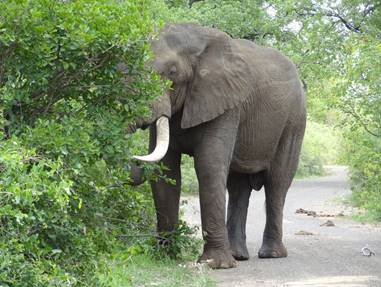
No prominent signs of musth!

This young cow was part of a maternal herd which was peacefully browsing amongst the trees just off the road. She, however, absolutely refused to let us pass. Each time we edged forward she came onto the road and faced us, trunk raised and trumpeting her poor opinion of us. And although she was not anywhere near the size of a bull (she was not even the largest of her herd), she was still considerably larger than we were. We took the hint, reversed a good distance, and had our breakfast. Eventually, the herd moved away from the edge of the road and we were able to continue our considerably delayed journey.
The photo below was taken between Olifants and Satara and I include it here to show the comparative sizes of the elephants. The cow to the right of the full grown bull is approximately the same age (going according to the tusk size) as the grumpy young lady above. Also, the African buffalo is by no means a small creature, yet a big elephant bull absolutely dwarfs them!
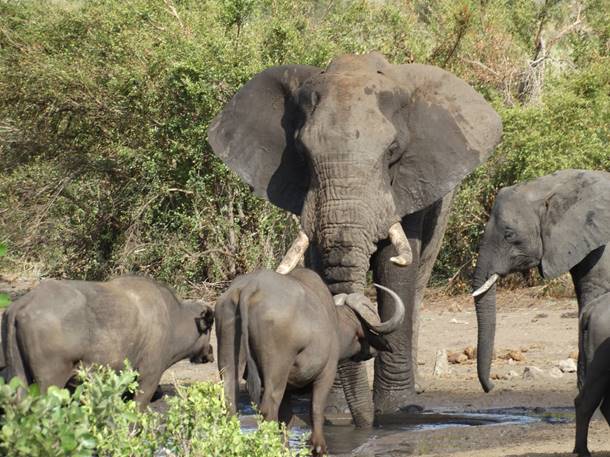
You are also likely to see storks and herons at the various pools, and, if there has been a kill, you will possibly see vultures too. As we have already seen the Black Stork at Tsendze, near Mopani, I have included a close-up of an immature one in the group below to show the difference.
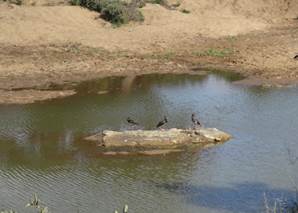
Part of a group of Black Storks

Close-up of Junior (he has a much paler beak).

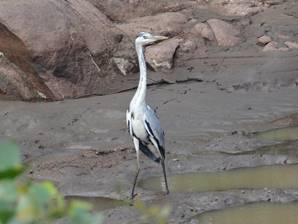
Grey Heron

Cape Vultures (with grey heads and dark faces) and Hooded Vultures (with grey heads and pale faces. The immature has a dark head.)

White-headed Vultures (with white feathers) and Hooded Vultures.
Unfortunately, the vultures above were a distance away and these were still the days of my rookie camera. I have therefore included close-ups taken elsewhere in the Park. I have never been close enough to the White-headed and Hooded Vultures to get decent close-ups.

Cape Vulture
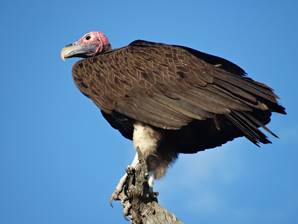
Lappet-faced Vulture
In the middle section of the loop, there are two places, accessed by smaller loops, which make great places for stopping for breakfast.
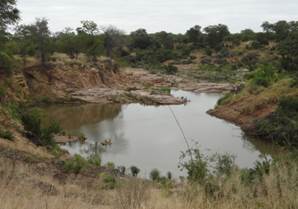
We have never seen this pool dry.
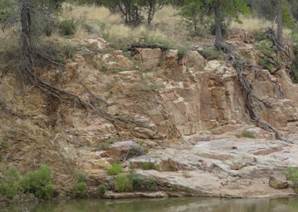
A close-up of the exposed root systems of the trees growing too close to the edge.
It was at the second spot, below, that I was absolutely thrilled out of my boots to have a European Bee-eater come and sit on a tree right next to the Isuzu while we were breakfasting! I was able to get some good shots in spite of the capricious weather. It was cloudy, but also very gusty (as can be seen by the ruffled feathers!) so there were opportunities to get good shots whenever the wind obligingly blew the clouds open.
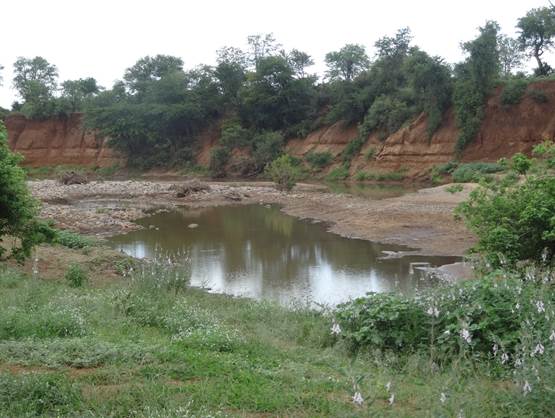

Breakfast under blue skies.
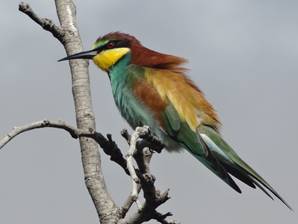
Minutes later, windy with grey skies!
One of our favourite birds is the Burchell’s Coucal, known to our family as the Tilly Bird. (For those who might be interested, you can go to the Dogs of Our Lives button and choose Idyll, the 30th story, for details concerning the Tilly Bird.)

A Burchell’s Coucal above another pool. (One of my favourite photos.)
Being a keen gardener, I always notice the vegetation as well, and the spring months deliver some beautiful flowers. Sadly, I do not have a clue what they are! There are also plenty of interesting trees, some of them twisted into the most amazing shapes.
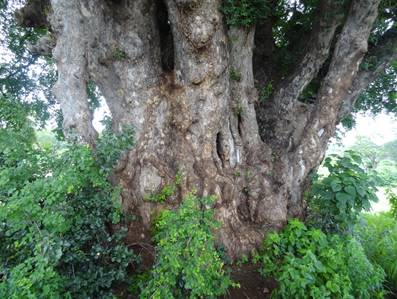
The riverbed can be glimpsed behind the tree.
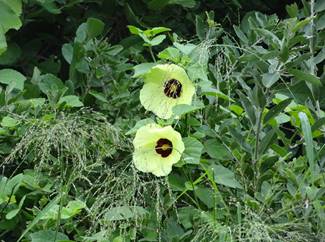
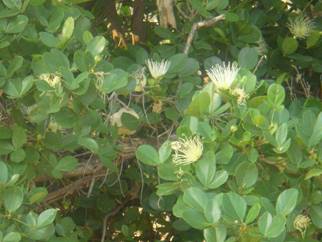
In fact, the whole Park is full of intriguing shapes which can cause you to stop (and even reverse) in order to investigate. The photo below (taken near Satara) is a case in point. It beautifully illustrates a common Park phenomenon, namely Imaginary Animal Syndrome. When you have been eagerly peering into thick bush for a while, you will be amazed at what tricks your eyes can play on you. We have identified a number of these creatures - our favourites are bushephants, rockoroceroses and stumpiraffes. In the photo below, we had to use our binoculars to correctly identify the bird we saw in the hollow of the tree trunk.
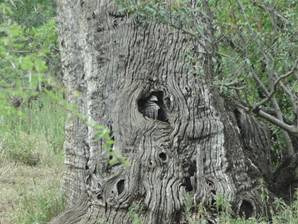

Thus far we have been focused on the river itself, but now we will turn our attention to the riverine vegetation. In the far north, the Pafuri Forest is a favourite destination for many lovers of the northern Park (we will eventually get there), but in my estimation, the Mphongolo riverine forest is equally as beautiful. Furthermore, it is far more extensive, stretching along two thirds of the route.
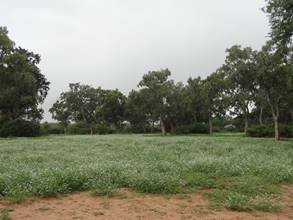
A forest glade.
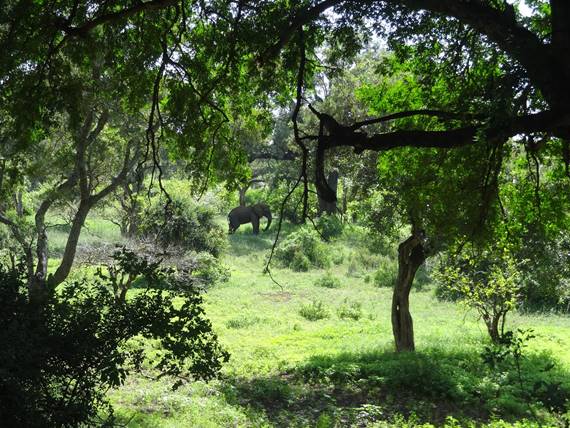
Another clearing in the forest.
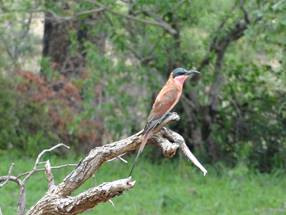
There was a host of Carmine Bee-eaters in this clearing in the riverine forest, swooping to and fro. We have mentioned them before, but it bears repeating that, like the rollers, bee-eaters tend to sit on bare stumps and branches between snacks so they are relatively easy to photograph. These stunningly beautiful birds are summertime visitors from the equatorial region.
I chose this photo as it also shows the Mphongolo river bed in the background.
Familiar inhabitants of the riverine forests are the Vervet Monkeys, which are a great favourite of those who aren’t familiar with them. They can be a huge nuisance in camps when they become habituated and lose their fear of humans. They will fearlessly come to the huts to forage and quickly learn how to raid fridges. We have had several sightings of humans dancing about angrily while Mr Vervet sits out of reach on the roof of the hut munching fruit he has just taken from their supplies.
They are not normally aggressive and will not launch unprovoked attacks, but they do bite in self defence. The worst thing you can do is to feed them. In fact, that is as good as signing their death warrant, especially in the Park, as they can become aggressive when you challenge them by trying to chase them off.
(We have a troop at home which visits a vacant lot behind our property about twice weekly. They tease the dogs mercilessly by sitting in the trees above the fence, just out of reach, dangling their tails most temptingly. One bolshie member of this troop once managed to take bananas from our kitchen, when our dogs were elsewhere occupied. On another occasion, when Bolshie Guy was clearly planning to come into the house to try his luck again, he bared his fangs at us most menacingly when we objected!) Nothing works faster to obliterate the cuteness factor, I assure you!
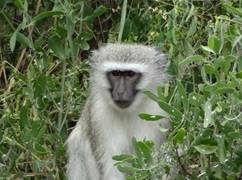


Vervet Monkey
We have already met Nyala and Bushbuck along the Kanniedood, but as your chances of meeting them, especially Nyala, along this route too are so likely, we cannot leave them out.

Bushbuck ewe with half-grown lamb
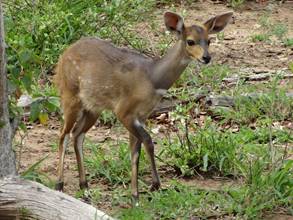
Close-up of the lamb
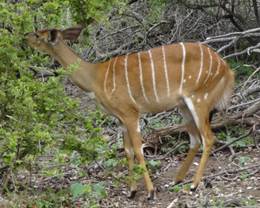
Nyala ewe
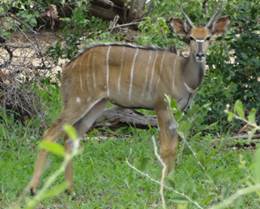
Young Nyala bull
As we have also mentioned before, in no other antelope species is the difference between the males and the females as stark as in the Nyala. If you are unfamiliar with them, you would not at first realise they are the same species! It is only when you see a young Nyala bull that you can trace the distinct changes which take place.
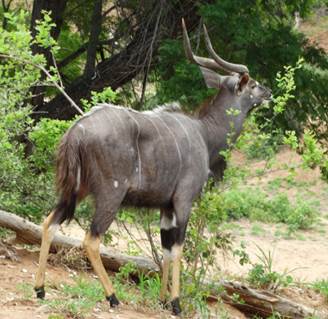
Mature Nyala bull
It was along this route that we had our first sighting of a Sharpe’s Grysbok. (Refer to Kanniedood for our best sighting ever.) We only caught a glimpse of it and we thought it might be a Steenbok. However, this puzzled us because the Steenbok prefers open savanna.
The photo below left will explain why we, in our ignorance, found it quite difficult to identify. Out of the corner of your eye you catch a movement. You slam on brakes. Whoops! It turns tail and disappears in a flash. All you have to help you is a momentary view of a little rear end! Now that we have more experience, the back view actually helps, as the Grysbok has a rounded posture while the Steenbok is very straight-backed. The colouring is also quite different. Although it is a reddish brown like the Steenbok, as you can see in the photo on the right, the coat has a grizzled appearance.
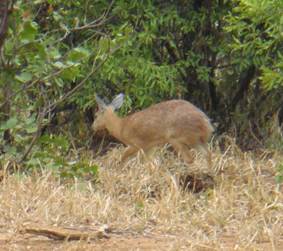

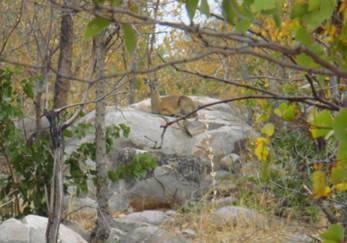
Another favourite small antelope of ours is the Klipspringer, which, translated from Afrikaans, is ‘rock jumper’. These are nearly always to be found on rocky hills and outcrops and we were very surprised indeed to find this one on the left along the Mphongolo, as most of the terrain is quite flat. We have never seen one again along this route.
They are such interesting animals that I am going to include some of those we saw down south, when I had a better camera!
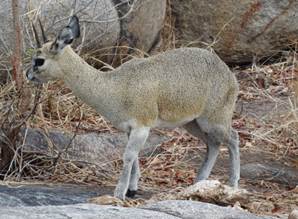
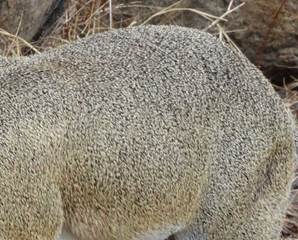
Note the very rough coat - it reminds me of hedgehog spines!
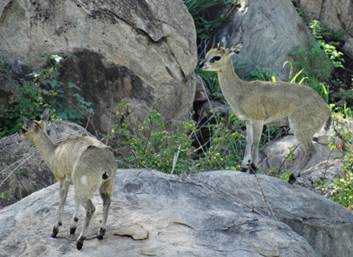
Daddy Klipspringer with his lamb

Above, note the unique hooves of the Klipspringer. It looks as though they are standing on tip-toe!
These two were seen on the rocky outcrops on the H1-1 just before the turnoff onto the H3 between Pretorius Kop and Skukuza.
Another unusual feature we have noticed about the Klipspringer: they are always in pairs. If you see one, you know the mate is not far away. All the other antelope we have seen are either solitary, in family groups, or in herds, but the Klipspringer pairs are completely devoted to each other.

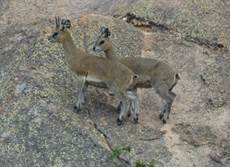
Above is a close-up of the same pair on the left. Their rock climbing abilities are quite breathtaking and it is amazing to see how quickly they scale the heights. This pair was on the S10 near Pretorius Kop.
As in other areas of the Kruger Park, where there is a regular supply of water, there you will find Waterbuck, and the Mphongolo Loop is no exception. We have already seen some of the Waterbuck to be found near the Nshawu Marsh, but I want to specifically show two features we did not mention then: They are instantly recognisable by the “dartboard” circles on their rear ends and their noses are a perfect heart shape!
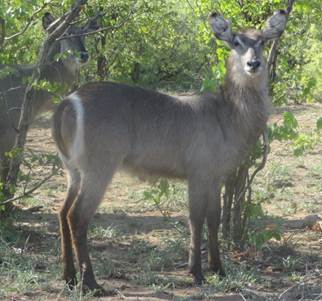
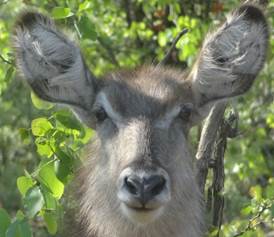
This is a half grown cow
One of our best sightings ever of Dwarf Mongoose was along this route. It was in my rookie camera days so, although we were very close, our photos do not do it justice.
I have not mentioned it before, but Barry (sometimes mentioned as my personal driver and/or husband) has a very quick and observant eye. (In the Park. Not so much when looking for something in the fridge at home.) He is our animal spotter-in-chief. On this occasion, I had just asked him if he was remembering to look out for the Dwarf Mongoose, when we turned a corner and, lo and behold, there they were!


This was in 2012 and the termite heap was still there in 2018, but we have never seen them there again. However, since then, we have kept a beady eye on all old termite heaps we pass!
To our surprise, within the next two hours, we had two more sightings - the first in yet another old termite heap and the next in a hollowed out log!

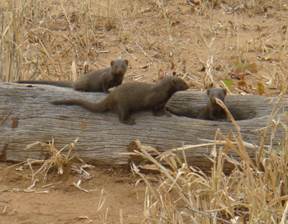
Besides other antelope such as Kudu (more about them in a later chapter), you can also be almost sure of seeing giraffe. In the photos below, take note of how they range in colour from light brown, through tan to chocolate. Apparently they darken as they age.



The photo below was taken with my ‘rookie’ camera but it remains my favourite giraffe photo. It was taken in the golden light just after sunrise. It struck me as such a romantic picture - the happy couple walking in the morning glow and into a long and happy future together. It also shows perfectly how the Mphongolo Loop winds its way through the riverine forest. If you look closely, you will see that the road forks off to the left onto one of the many minor loops to the river.

But, when viewing the photo above on our television set, I noticed what had escaped my attention before (namely their testicles). What a disillusionment! That they were of equal size should have been a clue. The television also revealed that both have bald horns. So, instead of a romantic tryst, these two were probably in the process of sizing each other up for a fight! (I still love the photo, though.)
I include the photo on the right (taken down south near Timbavati) to show what a mating pair actually looks like. Notice that the female is considerably smaller than the male.


All the Mphongolo photos shown so far, (with the exception of the scooting Grysbok) were taken on the first two sections of the Mphongolo Loop. The third section, which stretches from the S57 to Babalala picnic spot, has different terrain. This is because the road now runs along the Shisha River, which flows into the Mphongolo just south of the S57. (See Map on left.)
The Shisha River at this point flows through narrow ravines and does not provide the same viewing as the Mphongolo. Also, the vegetation is more thickets than riverine forest. Apparently, there is a resident leopard near Babalala, but so far it has eluded us. (In fact, there must be plenty of leopards along the whole route, but again, we have not been blessed with any sightings.)
What this section does provide, however, is a host of birdlife. It was along here that we at last had the opportunity to photograph a Brown-headed Parrot. Unfortunately, it was directly into the sun, so the photo does not do the bird justice. Very frustrating when you do have brilliant sunshine but it is coming from the wrong direction! (The Cinnamon-breasted Bunting below was taken near Olifants. I have used it because the one we saw along the Shisha was very high up and all we got was a lovely view of its belly and tail!)

Brown-headed Parrot

Cinnamon-breasted Bunting

Fork-tailed Drongo

Drenched Burchell’s Coucal with drenched breakfast!

Woolly-necked Stork

Juvenile Martial Eagle
Our Mphongolo drive ends at the Babalala picnic spot where we rejoin the H1-7 to return to Shingwedzi. It is nearly always a worthwhile drive, if you time it correctly. We once tried an early morning drive, in the hopes of seeing a leopard, and had very few sightings. Mid-morning to late afternoon is the best time.
We like to leave Shingwedzi early and then travel along the H1-7 as far as Babalala. (This section of the H1-7 is quite busy even in the early morning, as you will see in our next chapter.) By the time we enter the Mphongolo Loop at Babalala, it is already mid-morning and animals have started coming down to the river.
For an afternoon drive, we use the southern entrance and then take either the first turn-off or the S57, depending on how much time we have, to return to the H1-7.
If you have enough time, and you are able to travel at a snail’s pace, and you take the loops, this could be a highlight of your trip.